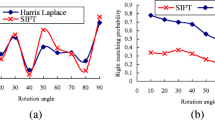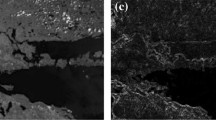Abstract
A feature detector named improved Harris–Laplace is proposed to obtain higher repeatability than that of original Harris–Laplace. In this novel method, all points detected at each scale are tracked and grouped beginning with the largest scale in the scale-space to make each group represent one local structure firstly. Then the point in each group which simultaneously leads to the maxima of corner points measuring and scale normalization Laplace function is selected. Finally, these points are described and matched by scale invariant feature transform (SIFT) descriptor successfully. Experimental results indicate that the proposed method has higher repeatability than original Harris–Laplace. Meanwhile, the new method was evaluated with image registration. Compared with SIFT, more accurate registration precision of multi-sensor remote sensing images was obtained by the advanced method.






Similar content being viewed by others
References
Brown M, Lowe D (2003) Recognising panoramas. Proceedings of the 9th International Conference on Computer Vision, Nice, France, pp 1218–1227
Columbia University, Coil-100 image database [OL]. http://www1.cs.columbia.edu/CAVE/software/softlib/coil-100.php.
Larios N, Deng H, Zhang W et al (2007) Automated insect identification through concatenated histograms of local appearance features. IEEE Workshop on Applications of Computer Vision, pp 26–32
Le Y, Zhang D, Holden E (2008) A fast and fully automatic registration approach based on point features for multi-source remote-sensing images. Comput Geosci 34(7):838–848
Lindeberg T (1994) Scale–space theory: a basic tool for analyzing structures at different scales. J Appl Stat 21(2):223–261
Lindeberg T (1998) Feature detection with automatic scale selection. Int J Comput Vis 30(2):79–116
Lowe D (2004) Distinctive image features from scale-invariant keypoints. Int J Comput Vis 60(2):91–110
Luo J, Ma Y, Takikawa E, Lao S, Kawade M, Lianglu B (2007) Person-specific SIFT features for face recognition. Proc IEEE Int Conf Acoust Speech Signal Proc 2:593–596
Mian A, Bennamoun M, Owens R (2006) A face recognition using 2D and 3D multimodal local features. Proceedings of International Symposium on Visual Computing, Lake Tahoe, USA, pp 860–870
Mikolajczyk K (2002) Detection of local features invariant to affine transformations, Ph.D dissertation, Institut National Polytechnique de Grenoble, France
Mikolajczyk K, Schmid C (2001) Indexing based on scale invariant interest points. Proceedings of the 8th International Conference on Computer Vision, Vancouver, Canada, pp 525–531
Mikolajczyk K, Schmid C (2004) Scale & affine invariant interest point detectors. Int J Comput Vis 60(1):63–86
Mikolajczyk K, Schmid C (2005) A performance evaluation of local descriptors. IEEE Trans Pattern Anal Mach Intell 27(10):1615–1630
Mikolajczyk K, Tuytelaars T, Schmid C et al (2005) A comparison of affine region detectors. Proceedings of International Journal of Computer Vision, pp 43–72
Qamra A, Chang EY (2008) Scalable landmark recognition using EXTENT. Multimed Tools Appl 38(2):187–208
Tangelder J, Veltkamp RC (2008) A survey of content based 3D shape retrieval methods. Multimed Tools Appl 39(3):441–471
Zhou H, Yuan Y, Shi C (2009) Object tracking using SIFT features and mean shift. Comput Vis Image Underst 113(3):345–352
Acknowledgements
This work was supported by the Natural Science Foundation of China (NSFC) (Nos. 60773172, 60805003) and Postdoctoral Fund of Jiangsu Province (AD41158).
Author information
Authors and Affiliations
Corresponding author
Rights and permissions
About this article
Cite this article
Zhang, J., Chen, Q., Sun, Q. et al. A highly repeatable feature detector: improved Harris–Laplace. Multimed Tools Appl 52, 175–186 (2011). https://doi.org/10.1007/s11042-010-0471-9
Published:
Issue Date:
DOI: https://doi.org/10.1007/s11042-010-0471-9




